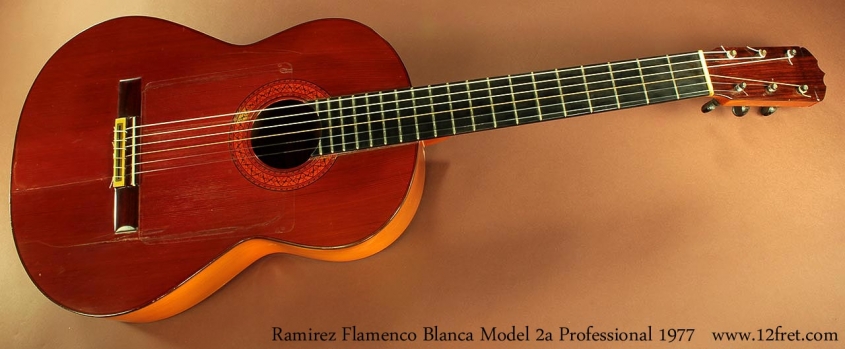| Serial Number | 11181, hand made in Spain 1977. |
| Pricing | $2650 CAD with case. SOLD |
| Neck | Standard Ramirez scale of 650mm, 52mm bone nut, Indian Ebony fretboard, Indian Rosewood peghead overlay, Brazilian rosewood friction tuners, Spanish cedar neck. Note that standard scale for Ramírez flamenco is 656mm so this 650mm scale must have been a special order. |
| Frets | Frets appear to be original: freshly dressed, recrowned and in good playing order |
| Body | Cypress wood back and sides, Rosewood binding, Red cedar top, Brazilian Rosewood bridge. Sound hole label signed by José Ramírez III. Secondary ink stamp indicates that the guitar was originally sold by a shop located in Spain. |
| Finish | Original Ramírez Urea Varnish finish. |
| Hardware/electronics | Original except for new Golpé tap plate |
| Playability/Action | Action set low at standard Flamenco action: 6/64 treble to 7/64 bass. Note: with Ramírez guitars, due to their proprietary tapered fretboard on the bass side, we normally measure the action at the 10th fret rather than the 12th fret in order to get a realistic indication of action height. Since the taper starts around the 11th fret, measuring at the 12th will give you a confusing idea of the overall action height on the bass string side. |
| Case | Used modern Italian-made Ramirez case |
| Comments | This guitar came to us 9 months ago in very sorry condition. Frets and fretboard, neck finish and Golpé plate showed many thousands of hours of playing time: “honest wear-and-tear” from a full life of making music.
Over the past 40 years of guitar restoration I find these older Ramirez guitars showing extensive wear sound exceptionally good once restored. Like a thoroughbred racehorse, penned up in a stall waiting for injuries to heal, this guitar has languished for years, waiting for a skilled repairman to restore it to racing form. Free it to gallop again ! The original worn Golpé plate was eased off the delicate top. All of the previously repaired top cracks were evaluated, opened and properly reglued. The decision was made to cleat all of the previously repaired top cracks to ensure strength and proper tonal vibration transfer across each of the repaired cracks. We felt it made sense to keep the original “grizzled” look of the guitar and not risk altering the tone by refinishing the top. Once complete, Dave passed the guitar on to me for a fret dress, recrown and polish. I refitted and properly eased the friction tuners. The bridge was converted to a 12-hole tie-block system: something I often do on Ramirez guitars. Done without removing the bridge, this greatly improves down-bearing on the saddle and speeds up string changing and improves new string stabilization. Years of wear on the back of the neck left many open exposed areas of the Spanish Cedar. Clear finish was slowly built up and eventually levelled and polished. The back of the neck is smooth to the touch but no attempt was made to disguise the touch-ups. The Golpé plate was a tough decision: the original was a large plate that crossed the entire bridge area. It ended at the long crack lines you see on the bass and treble sides running forward from roughly the end of the bridge feet. All older Ramirez guitars cracked here due to the seasonal humidity stresses between the ultra thin top and the rigid Golpé plate plastic. I prefer to install two smaller plates which restricts the top less and allows it to breath acoustically. Many of my Flamenco clients prefer very small tap plates: We are happy to remove the existing plates and increase or decrease size according to your needs. The guitar was fully setup with D’Addario Pro Arte Composite strings, Standard Hard tension: one of my preferred strings for Flamenco. The guitar sounds great though I encourage players to be open to trying a variety of strings on older flamenco guitars. Historically they used relatively low tension strings but each and every guitar has a different voice. Best to experiment. D’Addario Hard Tension is actually a relatively low tension string compared to other brands so it is a good place to start. If you are new to friction peg tuners, they are simple and fast to use but require a special trick to tune. Speak with me if you want a brief lesson…a YouTube lesson is in the works but not published yet. Once you have the knack, they are faster than conventional tuners and work beautifully. Though our Luthiers certainly can restore and refinish this guitar to brand new condition, I recommend keeping the original patina. A complete refinish would hide the historical wear: a function of the thousands of hours of music performance: part of the spirit of this guitar: war-torn but a survivor. A fine hand-made instrument that will continue to make music well into the 22nd Century ! Grant MacNeill |
You can preview our videos now on Our YouTube Channel!
You can now Visit our Facebook page!











